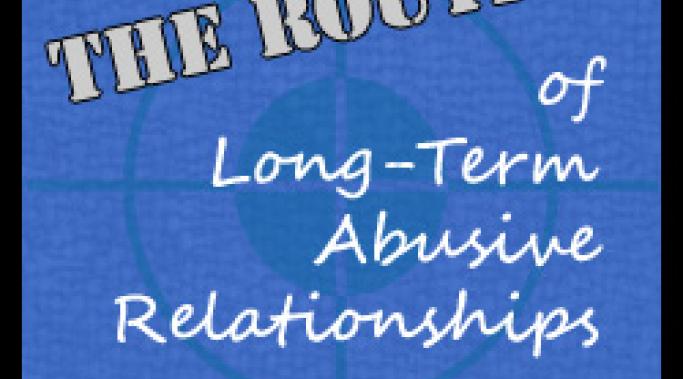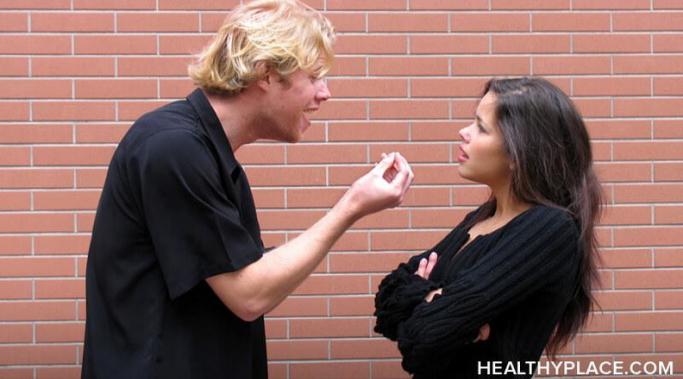How can you recognize verbal abuse disguised as a joke? Here's the thing: a loving partner will never call you ugly or stupid, even as a joke. A respectful husband or wife won't ever deliberately put you down in front of other people for a laugh. That's because it's not funny, it's verbal abuse thinly disguised as a joke.
Signs and Symptoms of Abuse
There is an important difference between arguments and verbal abuse. Have you ever heard the expression, "You can't see the wood for the trees?" That's how a verbally abusive relationship made me feel. I spent so long trying to unpick my partner's behavior that I became blind to it, all the while thinking that if I could somehow do better, be better then the abuse would stop (Do You Abuse Yourself with Self-Blame?). I was in denial. I told myself that all couples argue. But I now know there is a clear distinction between normal relationship arguments and verbal abuse.
Scientists study female domestic violence offenders more than in the past. Men and women differ in many ways, and no one knows if female domestic violence offenders' motivations to commit violence will turn out to be the same as male motivations. But seeing as we must start somewhere, it seems logical to begin with what we know about male offenders.
The research on female domestic violence offenders currently follows the research found relating to male offenders, namely the type of attachment style in intimate relationships, trauma symptoms and personality disorders. What can men look for to spot a female domestic violence offender?
A verbal abuse quiz can do a lot of things. It can help you determine if you suffer from verbal abuse. It can change your mind about what verbal abuse is and is not. A verbal abuse quiz can even show you that (eek!) you abuse other people. But a quiz cannot make you be honest. So if you are not ready to take an honest look at your situation, then don't bother with this verbal abuse quiz. It can't help you if you lie.
The effects of verbal abuse hurt me in both the short-term and long-term. Short-term effects of verbal abuse were the sting of his words or suggestions and the long nights spent crying silently to myself, figuring out what I needed to do to make the relationship better. Long-term effects, for me, are posttraumatic stress disorder and major depressive disorder. Some victims of abuse suffer dissociative identity disorder, too.
How does that happen? Why does a healthy person become a victim suffering from mental disorders?
Years ago, I bore two sons into my abusive marriage. Young and naïve, I thought my husband would change into a loving man when he felt unconditional love from and for the children. I thought that real love would end his cruelty toward me, and that he and I would create a loving family. I thought wrong.
The prior post discussed the relationship between the abuser and victim, then explored what each partner thinks during the routine. This post digs into the abusive relationship feelings and behaviors of the victim and abuser during a long-term abusive relationship.
The routine merges the cycle of violence and abuse phases of the honeymoon and tension-building, and it develops over a period of time. Typically we see the routine only in long-term abusive relationships because it enables both victim and abuser to manage their diseased relationship without expending as much emotional, mental, or physical energy as they did when the relationship was new. (The routine is also covered in this post on the routine and cycle of violence and abuse.)
The cycle of violence and abuse typically consists of three phases: tension-building, abuse, and honeymoon. The first two phases describe themselves and the honeymoon phase occurs after the abuse and gives the abuser a chance to beg the victim's forgiveness or otherwise convince the victim to stay. Over time, the tension-building and honeymoon phases tends to shorten or disappear, leaving us to wonder why abusive relationships can last so long. This routine makes staying in an abusive relationship manageable; both victim and abuser come to accept this routine as normal.
We tend to speak of the cycle of violence and abuse as if it were a constantly turbulent system, but we rarely discuss the routine that makes it easier to stay in an abusive relationship, the mind game that soothes the volatile system into manageability. The wheel of violence and abuse shows the cycle concisely, but too narrowly. The wheel shows the cycle as a rolling circle of abuse, honeymoon, tension-building, abuse, honeymoon, tension-building, abuse -- visually repeated infinite times with arrows circling around the wheel until we say to ourselves, "I get it! It's so simple." But then we feel shocked that victims of abuse don't just leave. After all, the wheel makes the cycle of violence and abuse so transparent that victims 'should be able to leave.' Despite its powerful (and necessary) message, the wheel simply cannot tell the whole story.









